14_Lecture_Presentation
英语课presentation的用法

英语课presentation的用法示例文章篇一:《英语课presentation的用法》嗨,大家好!今天我想和大家聊聊英语课上的presentation呢。
你知道吗?在英语课里,presentation就像是一场小小的表演秀。
想象一下,你就是舞台上的小明星,要把自己知道的东西展示给大家看。
比如说,你要介绍你最喜欢的动物,那这个时候,你的presentation就是把关于这个动物的所有有趣的事儿都告诉同学们。
我记得有一次,我的同桌小明要做一个关于大熊猫的presentation。
他可紧张啦,就像怀里揣了只小兔子,心扑通扑通直跳。
他站在讲台上,刚开始声音还有点小,就像蚊子嗡嗡叫。
他说:“同学们,大熊猫可好玩儿了,它们长得圆滚滚的,黑白相间的毛就像穿了一件特制的大外套。
”然后,他越说越激动,声音也越来越大。
他还拿出自己画的大熊猫图片给我们看,说:“你们看,这大熊猫的黑眼圈,就像戴了一副大墨镜,酷不酷?”我们都被他逗笑了,也对大熊猫有了更深的了解。
这就是presentation的魔力呀,能让大家通过你的讲述,看到一个全新的世界。
那在做presentation的时候,内容是很关键的。
不能只是随便说说,得有条有理。
就像盖房子,得先有个好的框架。
比如说,你要介绍一个地方,你可以先从这个地方的地理位置说起,就像告诉大家这个房子建在哪里一样。
然后再说说这个地方有什么特别的景点呀,就像是房子里有什么特别的房间一样。
接着呢,可以讲讲那里的人们的生活习惯,这就像是房子里住的人有什么特别的生活方式。
要是你东说一句西说一句,同学们就会像走进了迷宫一样,晕头转向的。
那怎么才能让自己的内容更吸引人呢?这就需要一些小技巧啦。
比如说,多讲点有趣的小故事。
我有个朋友小红,她在做关于英国的presentation的时候,就讲了一个英国女王的小趣事。
她说:“你们知道吗?英国女王特别喜欢小狗。
有一次,她的小狗在皇宫里调皮捣蛋,把一个大臣都给弄懵了呢。
presentation部分的作用和如何实现这部分的教学
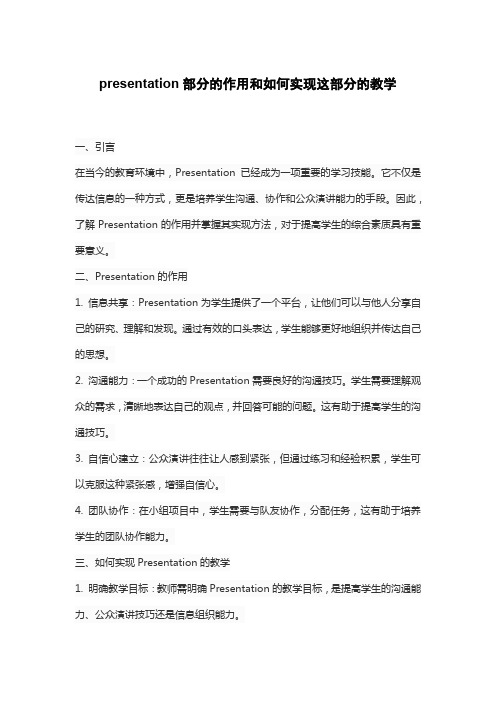
presentation部分的作用和如何实现这部分的教学一、引言在当今的教育环境中,Presentation已经成为一项重要的学习技能。
它不仅是传达信息的一种方式,更是培养学生沟通、协作和公众演讲能力的手段。
因此,了解Presentation的作用并掌握其实现方法,对于提高学生的综合素质具有重要意义。
二、Presentation的作用1. 信息共享:Presentation为学生提供了一个平台,让他们可以与他人分享自己的研究、理解和发现。
通过有效的口头表达,学生能够更好地组织并传达自己的思想。
2. 沟通能力:一个成功的Presentation需要良好的沟通技巧。
学生需要理解观众的需求,清晰地表达自己的观点,并回答可能的问题。
这有助于提高学生的沟通技巧。
3. 自信心建立:公众演讲往往让人感到紧张,但通过练习和经验积累,学生可以克服这种紧张感,增强自信心。
4. 团队协作:在小组项目中,学生需要与队友协作,分配任务,这有助于培养学生的团队协作能力。
三、如何实现Presentation的教学1. 明确教学目标:教师需明确Presentation的教学目标,是提高学生的沟通能力、公众演讲技巧还是信息组织能力。
2. 制定教学计划:根据教学目标,制定详细的教学计划,包括教学内容、教学方法和评估标准。
3. 激活学生的前知:了解学生已有的知识和经验,以便更好地引导他们进行Presentation。
4. 教学策略选择:选择适合的教学策略,如小组讨论、案例分析或角色扮演等。
5. 练习与反馈:为学生提供充足的练习机会,并给予及时反馈,帮助他们改进。
6. 评估与反思:制定评估标准,对学生的Presentation进行评估,并反思教学方法,以便进一步提高教学效果。
四、结论Presentation在教育中的作用不容忽视。
它不仅能够提高学生的沟通能力、自信心和团队协作能力,还有助于培养学生的综合素质。
为了实现良好的Presentation教学效果,教师需要明确教学目标、制定教学计划、选择合适的教学策略、提供充足的练习机会和及时的反馈,以及进行有效的评估和反思。
英语Presentation讲稿
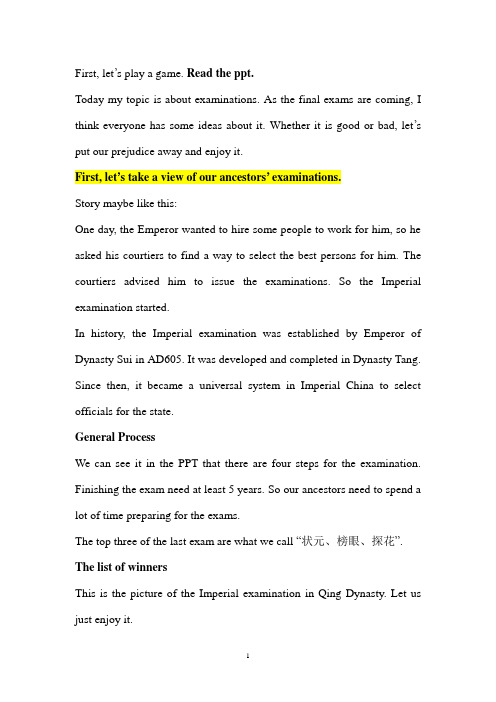
First, let’s play a game. Read the ppt.Today my topic is about examinations. As the final exams are coming, I think everyone has some ideas about it. Whether it is good or bad, let’s put our prejudice away and enjoy it.First, let’s take a view of our ancestors’ examinations.Story maybe like this:One day, the Emperor wanted to hire some people to work for him, so he asked his courtiers to find a way to select the best persons for him. The courtiers advised him to issue the examinations. So the Imperial examination started.In history, the Imperial examination was established by Emperor of Dynasty Sui in AD605. It was developed and completed in Dynasty Tang. Since then, it became a universal system in Imperial China to select officials for the state.General ProcessWe can see it in the PPT that there are four steps for the examination. Finishing the exam need at least 5 years. So our ancestors need to spend a lot of time preparing for the exams.The top three of the last exam are what we call “状元、榜眼、探花”. The list of winnersThis is the picture of the Imperial examination in Qing Dynasty. Let us just enjoy it.About the Imperial examinationThis system had a huge influence on both economy and culture to Imperial China.Neighboring Asian countries such as Japan, Vietnam and Korea also had similar systems, which were learned from China.But its disadvantages are obvious. For example,Limit people’s imaginationOnly focus on ability, but not moralitySpread the utilitarianism and bureaucracy……College Entrance ExamI think we must be very familiar with these pictures. Because all of us have taken College Entrance Exam before we enter university.When we talked about the college entrance examination, what we associated was “Black June,unfair, suffering, Test Machine, Tiring and exhausted”.To get a good mark, every examinee has to work hard to struggle. It is a really painful time, yet still has something meaningful and happy.At that time, everyday seems to be monotonous, but we seek joy amidst sorrow. Though we had a lot of homework and papers to do, we didn’t lose confidence. Even when some times we feel depressed, we tell ourselves “A fig for this! Just a few months on this”.SharingIn fact, when I now look back on those days, the feelings are complex, just as an old saying goes, if a person did not experience the college entrance examination, his life can not say completed. Recalling those days, with a faint hint of sadness and endless aftertaste, I really feel happy and proud.The Independent RecruitmentI think many of us may take part in last year’s Independent Recruitment. But have you heard the news about this year’s Independent Recruitment? There are three big groups this year. They are Tsinghua University Union, Peking University Union and Tongji University Union.However, it doesn’t seem to be warmly welcomed this year.Our clever Chinese netizens created two interesting names for those groups, “huayue and beiyue ”, to show their attitude to it. What’s more, there are some experts criticizing the three groups for their malicious competition.About The Independent RecruitmentThe original intention of the independent recruitment is to create more opportunities for students who have special ability but can’t be admitted to university in normal ways. But it now has become a game for some colleges to vie the outstanding students.In the U.S. Ivy League universities, candidates can enjoy the unlimited choices; they can apply for any college as they like.Universities in China have once had a high degree of self-enrollment and could give the candidate the full right to choose.So if today’s independent admission can think more for the examinees, rather than “fight” with each other, the independent recruitment then will really benefit China's education.。
英语课演讲presentation作业幻灯片课件

Thank You!
-that's all-
Why?
Why Korean TV series in China's response is so well? Why people so crazy about Ko rean TV series ? Why Korean TV series ar e successful ?
one:
handsome actor,beautiful actress,meet the audience's fantasy...eg:a Cinderella story,the fairy tale of prince and princes s...
Thinking:
Some say,it's because Korean are making the Korean TV series to be their national c ulture ,that their series are successful.I thi nk it's just reflect a rigorous attitude towa rds art and audience.Spare no effort to sh ow the best works to audience not just fo r money.Hope one day Chinese TV series can also rock the world!
Байду номын сангаас
✓ 《Full House》✓ 《Miss Merma
id》
Historical play
✓ 《The Great Jang-Geum》 ✓ 《iljimae》
英语Presentation教程资料
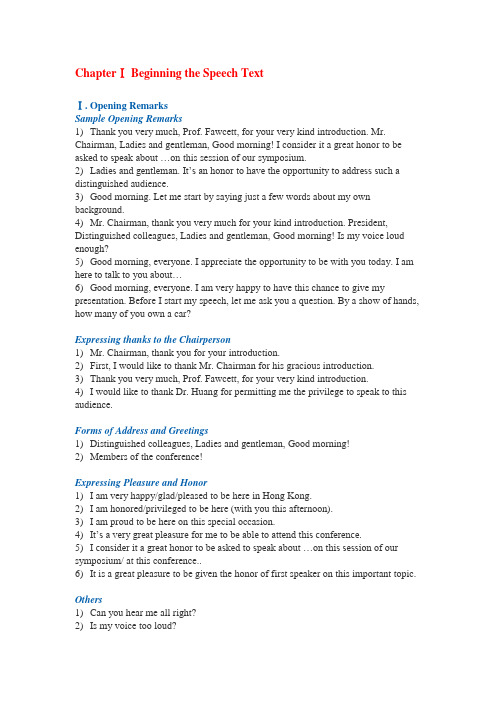
ChapterⅠ Beginning the Speech TextⅠ. Opening RemarksSample Opening Remarks1)Thank you very much, Prof. Fawcett, for your very kind introduction. Mr. Chairman, Ladies and gentleman, Good morning! I consider it a great honor to be asked to speak about …on this session of our symposium.2)Ladies and gentleman. It’s an honor to have the opportunity to address such a distinguished audience.3)Good morning. Let me start by saying just a few words about my own background.4)Mr. Chairman, thank you very much for your kind introduction. President, Distinguished colleagues, Ladies and gentleman, Good morning! Is my voice loud enough?5)Good morning, everyone. I appreciate the opportunity to be with you today. I am here to talk to you about…6)Good morning, everyone. I am very happy to have this chance to give my presentation. Before I start my speech, let me ask you a question. By a show of hands, how many of you own a car?Expressing thanks to the Chairperson1)Mr. Chairman, thank you for your introduction.2)First, I would like to thank Mr. Chairman for his gracious introduction.3)Thank you very much, Prof. Fawcett, for your very kind introduction.4)I would like to thank Dr. Huang for permitting me the privilege to speak to this audience.Forms of Address and Greetings1)Distinguished colleagues, Ladies and gentleman, Good morning!2)Members of the conference!Expressing Pleasure and Honor1)I am very happy/glad/pleased to be here in Hong Kong.2)I am honored/privileged to be here (with you this afternoon).3)I am proud to be here on this special occasion.4)It’s a very great pleasure for me to be able to attend this conference.5)I consider it a great honor to be asked to speak about …on this session of our symposium/ at this conference..6)It is a great pleasure to be given the honor of first speaker on this important topic. Others1)Can you hear me all right?2)Is my voice too loud?Reference to the Audience1)I can see many of you are from …department.2)I know many of you are familiar with this topic.3)You all look as though you’ve heard thi s before.4)I understand that you’ve all traveled a long way./ After hours of conference, you must feel a little tired. Now I’d like you to see an interesting topic…II. Introducing the Subject and the outline of the PresentationBackground Information1)I would like to start by briefly reviewing the history of open heart surgery.2)Let us start with the theoretical basis of this new technique.3)To begin with, we have to consider the principle.4)I think it would be best to start out by looking at a few slides.5)I should like to preface my remarks with a de script ion of the basic idea.6)May I begin with a general outline of this project?7)The first thing I would like to talk about is the definition of the terms I shall use in my lecture.8)The first point I'd like to make is the historical background of the invention.9)First, I shall explain to you why this new program is correct and feasible.Topic1)I would like to concentrate on the problem of antibiotic abuse in hospitals.2)I shall devote my talk to the surgical treatment of coronary disease.3)I want to confine my talk to the latest developments in civil engineering.4)Today, I am going to give a talk on the application of computers in medicine.5)My topic today will deal with the observation of supernova.6)In today's talk, I' 11 restrict myself to the etiology of 15-epa~i;s.7)In my presentation this morning, I' 11 limit myself to three major points only.8)I take the liberty of restricting my discussion mainly to highway bridge construction.9)Now, I would like to address myself to the most important aspect of this problem.10)Among the many languages, I shall mention only BASIC.11)What I am going to present today is the methodology and the data analysis.12)I'm not going to say much about that except to discuss the literature on that topic. Outlining1)My talk today consists of two parts. One is... and the other is...2)I've divided my presentation into four parts.3)I shall first talk about ... and then touch on... and finally discuss ...4)The subject can be looked at under the following headings: ... (Pointing to the PowerPoint display)5)I would like to divide my talk into two parts. The first part deals with…, the second part concerns ...6)My presentation will be given in four parts. The first part deals with ... The second part relates to... The third part concerns ... And the last part discusses…Purpose/Objective1)The purpose of this presentation is to...2)This talk is designed to…Comprehensive SamplesSample 1Thank you, Mr. Chairperson, Mr. Director-General, distinguished members of the ILO's Governing Body and friends. I welcome this opportunity to be here today, with an Organization which in many ways belongs to all of us workers. I can think of, in fact, no other international body that one can claim as one's own so unambiguously.I have also had a longstanding formal association with the ILO. Many of my early pieces on women and technological change and on land rights were published by the ILO, as well as was the work of many other scholars. It is therefore a pleasure for me to be here on this important Symposium.The canvas of the Symposium is very large. I will focus on two aspects ofgender inequality that centrally effect millions of women as workers but perhaps have failed to receive the attention they deserve. First, the gender gap in command over property and Productive assets and, second, gender biased social perceptions and social norms.Sample 2I learned last May that you have to be careful in speaking to a group of professional communicators. After I conducted a writer' s workshop at the Toronto Conference of the International Association of Business Communicators, Janine Lichaczwrote asked me to speak here tonight and used the communication techniques I had recommended. She even included a footnote citing my lecture. I am susceptible to good communication and to flattery so I am pleased to be with you to discuss your topic for the evening, the use of language in the art of speech writing.I suppose we must begin by shaking our heads, woefully, over the sad state of language today, whether in formal speeches, casual conversation, or in writing. Most of us in this room no doubt agree with the generally negative tone of Time Magazine's year-end assessment which claims “our language has been besieged by vulgarities”. But to preserve our sanity as professionals in communication of us would probably join Time in optimistically expecting English somehow to survive and even to prosper.Expressions on Other OccasionsCorrecting the Title of the Presentation1)First of all, I would like to mention that the title of my presentation should be ...2)Please allow me to correct a mistake in the title of my speech which appeared in the program. Instead of... it should read...Reading Another Person's Paper1)Sometimes you are selected to read another person's paper, as he or she is absent.2)I shall read a paper by Dr. Li from Guangzhou, china, who regrets that he could not be here. The title of his paper is...3)I'm going to read the paper by Dr. Wang. It's a great pity that, because of a health problem, he could not be here.4)I was asked by the author to read his paper. He apologizes for not being able to come here.5)The next speaker, Prof. Zhang, regrets that she could not be here and has submitted her paper to me. I am not sure if I can present it as well as she expected. 6)I am not sure whether I' 11 be able to be very confident in answering specific questions. However, I am somewhat familiar with his work, so I' 11 try my best. Checking the Microphone1)First I want to check if all of you can hear me clearly.2)Am I speaking clearly and loudly enough for those in the rear of the room?3)I wonder if those in the rear of the room can hear me.4)If those in the rear of the room can hear me, would someone please raise his hand?5)Can you hear me clearly?6)Can you hear me if I am away from the microphone?7)Is the microphone working?* Summary-How to Prepare a Good Introduction1)Realize file great importance of the introduction of file presentation mad then do your best in delivering it.2)Don't make file introduction either too wordy, or too brief. Usually, it covers 10 to 15 percent of your entire speech.3)Select tile ways to capture the audience attention.4)Indicate tile topic.5)Outline your Speech.6)Announce your purpose.7)Prepare several versions of tile introduction, compare them, and then select the best version. Finally, learn it by heart so as to be able to deliver it easily mid fluently.8)Don't start your speech with apologies.9)Pay attention to your body language.Chapter II Developing the Speech TextI. Announcing the Beginning of the Speech Text1)To begin with, I would like to talk about a principle.2)I think it would be best to start out by looking at some pictures.3)The first thing I would like to talk about is the definition of the terms which I’11 use in my presentation.II. Shifting to the Next Main Point1)Well, let's move on to the next point.2)We will now come to the second problem.3)Turning to the next question, I' 11 talk about the stages of the procedure.4)As the second topic, I shall stop here. Now let's turn our attention to the third topic.5)So much for the methodology of our experiment. I would now like to shift to the discussion of the results.6)Now, let's move away from the first part and switch over to the next part of my presentation.7)That's all for the introduction and now we can go on to the literature review.8)Next, I would like to turn to a more difficult problem.9)The next point I'd like to talk about is the feasibility of this project.10)That brings me to my second point.11)I am glad that we can now leave this rather boring subject of mathematic deduction and go into a more attractive one that is the application of the formula. III. Resuming the Topic1)Let's come back to what I said in the first part of my speech.2)Getting back to the subject of the problem of theoretical considerations we can find that...3)I want to return to the first part of my presentation.4)Now, to get back to the effect of temperature, you may be aware that the problems have been solved.5)This brings me back to the question of security.6)At this point I would like to refer again to the question of methods in the first part of my lecture.7)Referring again to the first question, I think...8)Referring to the Coming Point9)I'll deal with it later.10)I' 11 touch upon that point in a moment.11)I shall tell you in detail shortly.IV. Introducing the Supporting Materials1)I think this part is the most difficult, so I'll explain it in greater detail.2)I think this part of my paper is most important, so I plan to spend more time on it.3)Please allow me to deal with this matter more extensively.4)Being the most important part of my presentation, I will elaborate on it with more slides.5)I' 11 expand this topic with drawings and figures.6)Indicating the Points Briefly7)Limited by the time available, I can only give you a very brief account of this matter.8)I don't think that I should describe the methods in detail, because they are included in the handout.9)I will not go into detail on it.10)This point has been talked about repeatedly in this symposium, so I am not going to spend too much time on it.11)Let's go through the following points very rapidly.12)I just want to outline for you what I experienced in using this new drug.13)I shall not go over all these explanations. My time is running short. So I'’11 be brief.14)It is sufficient to say that these experiments were poorly designed and without controls.V. Repairing a Slip of Tone1)The first of such experiments began in 2000, rather than 1999.2)May I have the lights, I mean the slides.3)The temperature increased, I shall say decreased.4)The population is 13 million, sorry, 31 million.5)The exchange rate dropped from 2.5 to 1.8, I beg your pardon, 1.9.6)As you can see from the first row, excuse me, the second row, that the output increased two fold.VI. Expressions Concerning Audio-Visual Aids1)Could we have the lights off? And the first slide, please.2)Lights off, first slide, please.3)Dim the lights, and first slide, please.4)The slide is not so clear. Please darken the room a little more.5)Could you please turn on the lights, please?6)Now, we can have the lights on.7)Please switch on the lights.8)Lights on, please.9)I apologize that this slide is not so clear, but I hope you can still make out the general idea.10)Sorry for the small print.11)I'm sorry we left a figure out here.VI. Explaining the Contents on the Slides1)This slide demonstrates ...2)On this slide, you can see...3)This curve in this slide shows...4)This figure in this slide exhibits...5)This table on this slide presents...6)This diagram on this slide depicts...7)This chart on this slide displaces ...8)The picture on this slide shows ...9)The photomicrograph on this slide shows ...10)The flowchart on this slide points out...11)The circuit diagram on this slide represents~...~12)Indicating the Sources of the Content in a13)This figure is taken from.., by Dr. Li.14)This diagram is after that of Prof. Wang with some modificationVII. Demanding to Show the Next Slide1)May I proceed to the next slide, please?2)I think we can move on to the next slide.3)Let me show you the next slide.4)Now, we can go on to the next slide. '5)Next slide, please.6)Next, please.7)Next!VIII. Returning to the Previous Slide1)To make a comparison, can we return to the first slide, please?2)Let's go back. No, not this one. One back. Back one more. Y es, that’s it. Thank you.3)May I go back two slides, please?4)Could you return to the second slide?5)May we have the previous slide again?IX. Correcting a Mistake1)Sorry, this one is in the wrong order. May I have the next one?2)Oh, this slide is misplaced. Please skip over it. Y es, this is the correct one.3)I'm afraid I didn't ask for this slide. Can we go back to the previous one? Please.4)No, not this one. Next, please. Y es, this is the one I need. Thank you.5)I'm afraid you may have lost one slide which is a flow chart of the procedure.6)Sorry, there seems to be one slide missing.X. Indicating the Speed of Running Slides1)Let's go through the following slides rapidly.2)The following three slides we will go through quickly without explanation.3)Wait a minute, please. I want to say more about this slide.4)Because of the shortage of time, I' Il have to omit the following slides.5)Time is up, let's come to the last slide directly.6)Would you please skip the next slid-e and go on to the table?7)Next, next. Go ahead... That's it.Chapter III Ending the Speech TextI. Signaling the Beginning of the End Part1)Let’s look at what I have talked about.2)Well, that brings me to the end of my presentation. This last slide is a brief summary of what I have talked about.3)Before I stop/finish, let me just say...4)To close my speech, I' 11 show you the last slide.5)Now I'd like to summarize my talk.6)To summarize, I have talked about three aspects of the cancer problem: ...7)Finally, as a summary statement, I would like to sum up the major points I have made.II. Summarizing1)Let me just run over the key points again.2)I'll briefly summarize the main issues.3)In conclusion, …4)In closing, , …5)In a word, …6)To sum up, …7)In brief, …8)Briefly, …9)All in al, …10)Finally, …III. Concluding1)As you can see, there are some very good reasons ...2)To sum up, my conclusion is that the present program is the best one.3)In conclusion ...4)Let me conclude my talk with the following comments.5)Allow me to conclude by listing out all the factors influencing the efficacy.6)In conclusion, I would like to point out the following aspects.7)I'd like to leave you with the following conclusion.IV. Quoting1)Let me close by quoting Dr. Einstein, the famous physicist, who said that…2)I would like to come to a close by quoting what Sir Newton once said...3)Therefore, I would suggest that we...4)I'd like to suggest...5)As far as I'm concerned, the only solution to the problem is...V. Closing1)That's all, thank You.2)That's the end of my presentation.3)So much for my speech, thank you.4)Thank you for your attention.5)Thank you for your listening.6)Other Expressions that May Be Useful in the End Part of the Speech7)Sorry, I see the red light is shining so I have to skip the last part and jump to the conclusion.8)Mr. Chairman is signaling me, I have to stop here and leave out the remaining part to spare time.VI. Samples[ Sample 1 ]We have proposed a framework of a hierarchical planning system for robots. First of all, the system is an automatic plan system that can guide the robot intelligently in terms of the environment. Secondly, it is based on hierarchical planning. The planning problem has been hierarchically decomposed into two sub-problems: global destination selection and local motion planning. And finally, the simulation and application has proved it as an effective design.(Show the last visual)That's all for my presentation. For any question to be raised, I'm quite willing to discuss them with you at any time. Thank you, every one.[ Sample 2 ] 'Finally, we can draw the conclusion: edge detection and denoising are two important branches of image processing. If we combine edge detection with denoising, we can overcome the shortcomings of the commonly-used denolsing methods and without blurring the edge notably.Furthermore, there are many denoising and edge detection methods now. Different methods are suitable for different types of images and noise models. We can do further research on how to combine these various denoising and edge detection methods according to the content of the images and nature of noise.That's all for my talk. If you have any questions, please do not hesitate to ask me. I'm quite willing to discuss them with you at any time, Thank you.[ Sample 3 ]That's all t wanted to show you about Machine Vision and one of its applications, AGV. Thank you OK, that is all I'm going to talk today.Thank you ![ Sample 5 ]That's all. Thank you!Chapter IV Asking and Answering QuestionsI. Inviting Questions1)So, let's throw it open to questions.2)Now I'd like to answer any questions, if you have any.3)Now I am ready to answer your questions, if any.4)I'd be glad to try and answer any questions.5)Are there any questions?6)Any questions?II. Raising QuestionsSignaling Your Intention to Ask a Question1)I want to ask Dr. Bi a question.2)I have a guest ion for Dr. Anderson.3)Mr. Smith, I have a question to ask you.4)There is a question I'd like to ask Prof. Li.5) A question for Mr. Liu.6)One question, Dr. Liu.7)Could I ask you a question, Prof. Li?8)May I venture to ask Prof. Zhang a question?Expressing Your AttitudeBefore asking your question, you can express your positive attitude or make a comment on the speaker's presentation. For example,1)Dr. Johnson, I was fascinated by your description of your study, but what will happen if...2)Mr. Li, you did splendid work! Just one question.Asking the Specific Question1)You mentioned very briefly that you used two experiments that were the same.2)Would you please elaborate on that point?3)Would you be so kind as to give me more information about the method of your experiment?4)Would you tell me the reason why you set such a high temperature? Comprehensive SamplesDr. Wang, I'd like to raise one question. First, may I say how much I enjoyed talk. But, may I ask, do you have experience with the new method?Congratulations, Dr. Li. I can't help but admire your achievement. But I want to know what's your attitude toward abuse of antibiotics?I'd like to congratulate Mr. Liu on a very interesting presentation.May I ask you a question? How does subjective evaluation differ from objective evaluation?First, I'd like to say your research is very interesting. May I ask two questions? Do you see any relation between cigarette smoking and peptic ulcers? And what advantage do you expect by using this approach?III. Response to QuestionsAsking for Repetition1)Pardon, I couldn't hear what you said.2)I beg your pardon. I didn't catch what you said.3)I'm sorry I forgot your first question. Would you be so kind as to say it again?4)I'm not quite surge what your question is.5)I didn't quite get the last point of your question.6)You mean, there may be some mistake in the calculation?7)Are you referring to the significance of the difference?8)Are you suggesting that the temperature might have affected the results?9)If I understand you correctly, you are saying/asking...10)I didn't quite catch that.11)Could you go over that again?12)I'm not sure what you're getting at.Welcoming the QuestionWelcome the question by saying "thank you" or commenting on it saying "That’s a good question" or "That's a challenging question."1)This is a very good question.2)Thank you for that question.3)I'm glad this question has been brought up.4)I appreciate that question.5)This is a hard question.6)This is an interesting question.7)This is a big question.8)I'd be delighted to answer your question.9)I'll try to answer this question very briefly.10)In answer to your question, I would say that...11)I can only provide a partial answer to that question.12)Let me try to answer your questions one by one.13)My answer to your first question is...14)May I answer your second question first?15)I have only a partial answer to your question.16)Thank you for that question. This is a challenging question and I'm afraid I can only provide a partial answer to it. Anyway, I'll try my best to answer it. Repeating or Paraphrasing the QuestionQuestioner: Have you tried it on human bodies?1)Presenter: This gentleman would like to know whether we have tried this onhuman bodies.Responding to Difficult or Challenging QuestionQuestion: So what happens if the new budget isn't approved?1)Answer (1): We've spent two months preparing the new budget. It's a good budget and we're confident we'll get approval to put it into practice.2)Answer (2): There is too much supposition in the question for me to give a sound answer.The following are some other examples of answers to challenging questions:3)Perhaps in another year or so we can answer that question, because these studies are now in progress.4)We are now working on this problem and, if you agree, I'll answer your question in a few weeks.5)The only answer I can give at present is to wait a few more years, at which time something better might ultimately come out of all our efforts.6)I think it will be possible to answer this question when more experiments are completed.7)The answer to this question needs further study.8)I hope I will be able to answer your question later.Responding to Improper Question1)I appreciate your interest in my research, but I just don't want to talk about it now.Let's talk about something else.2)I'd rather not say.3)Why do you want to know?4)Sometimes you can relay the question back to the questioner. For example,5)Before I answer you that question, let me ask you: where do you think we shouldhave the project?6)In this way, sometimes you encourage the questioner to answer his or her ownquestion, e.g. "What do you think? Are people prepared to pay an extra $ 2 for faster service?"Responding to the Questions You Do Not KnowIf you don't know the answer to a particular question, simply admit that you don't know. Say something like this:1)"I'm sorry. I don't happen to know the answer to that question, but I'll be happy tocheck into it for you."Here are some further examples:2)I don't think I can answer your question.3)I wish I could answer your question, but unfortunately I have no good answer.4)I'm not sure that I can answer your question. What I'm going to say is not quite ananswer to your question.Another technique to cope with the situation is to direct the attention to another expert who may know it or you can use the audience. Ask if anyone could help the questioner and hence it won't be necessary for you to admit that you do not know the answer. See examples below.1)I think that question could be better answered by Dr. Liu than by me.2)I think perhaps Dr. Chen would be better able to answer this question.3)Prof. Li would be a better person to answer your question since he has done a lotof work in this field.4)Fortunately, Prof. 'Ma, who is an authority in this area, is 'here. I think no one ismore suitable than him to answer your question.5)Dr. Sawyer is perhaps in a better position to tell us something about it.6)Perhaps my colleague Dr. Emery here has some better ideas.7)I think it would be better if Prof. Wu were to make some comments on this matter.Avoid using the following expressions to embarrass the questioner:"I've already answered that but you obviously weren't listening." Instead say something like "I'm sorry I didn't explain that clearly."Avoid talking to one questioner. Look towards the other, side of the conference hall or room and indicate that there is another question. Suggest that as there are several more questioners,' yon could discuss his or her question in more detail after your talk. Referring Back to the QuestionerHaving finished answering questions, you should check that the questioner is satisfied or further elaboration or explanation is called for. The following expressions might be helpful.1)Did I answer your question?2)Did I answer you satisfactorily?3)Did your question get answered?4)I don't know whether this answered your question.5)I don't know if this is a satisfactory answer.6)I hope this may serve as an answer to Dr. Li.7)I hope this answers our question.Sometimes when question lime is over and ff time permits, you can restate, your main proposition, including any good comments from the audience and ignoring adverse questions or remarks. Thus, you demonstrate that you are confident mid can cope calmly with controversy.Remember that your last words to the audience will be retained longest and you are expected to behave in a professional manner.Chapter V Talking During the BreakI. Useful encouraging phrases to show your interest and to stimulate the flow of conversationThen what happened? Good. Ah.Really? Right. That's right.Oh? Right, I will. Go on...Oh, hmm. I think it's a good one. For instance.Yes. No. For example.Yes, of course. Sorry, I can't. Such as.Yes, that's right. I'm afraid not. Tell me more.Yes, I do. Well, not really. Then?Yes, he was. Perhaps not difficult. Really?Yes, we were. Erin, I don't know. Is that right?Very nice. I really can't manage it. Is that so?Very good. Not very nice. Are you sure?Very clear. Very bad. (laughter) .....Really nice. Very disagreeable.Quite nice. Really nasty. (silence...)Quite, absolutely true. Aha.。
英语Presentation演讲稿
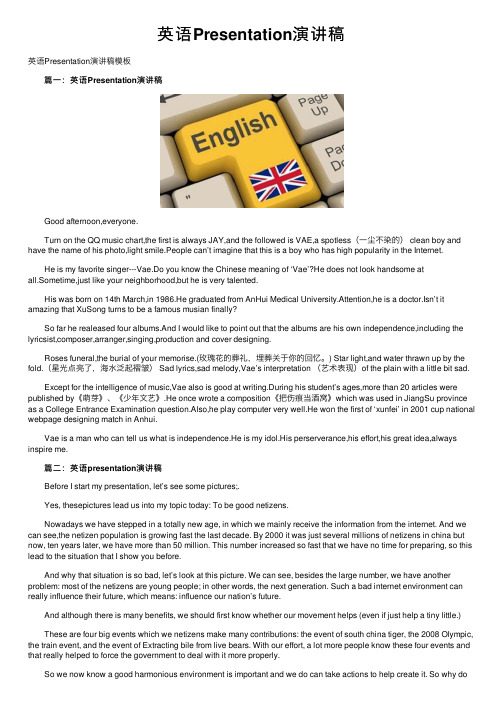
英语Presentation演讲稿英语Presentation演讲稿模板篇⼀:英语Presentation演讲稿 篇⼀:英语 Good afternoon,everyone. Turn on the QQ music chart,the first is always JAY,and the followed is VAE,a spotless(⼀尘不染的) clean boy and have the name of his photo,light smile.People can’t imagine that this is a boy who has high popularity in the Internet. He is my favorite singer---Vae.Do you know the Chinese meaning of ‘Vae’?He does not look handsome atall.Sometime,just like your neighborhood,but he is very talented. His was born on 14th March,in 1986.He graduated from AnHui Medical University.Attention,he is a doctor.Isn’t it amazing that XuSong turns to be a famous musian finally? So far he realeased four albums.And I would like to point out that the albums are his own independence,including the lyricsist,composer,arranger,singing,production and cover designing. Roses funeral,the burial of your memorise.(玫瑰花的葬礼,埋葬关于你的回忆。
presentation 单词
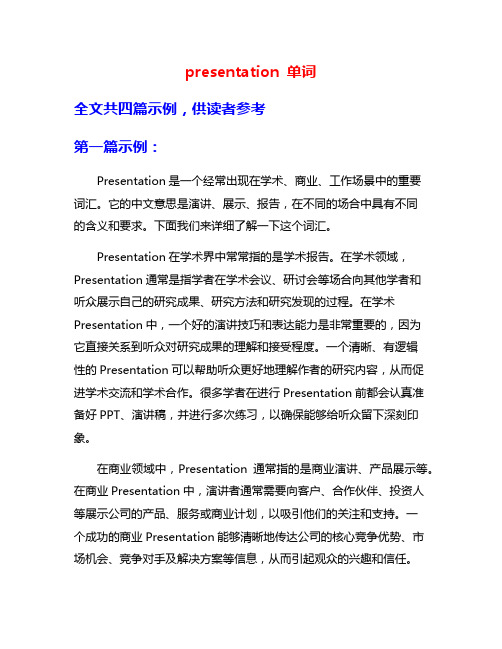
presentation 单词全文共四篇示例,供读者参考第一篇示例:Presentation是一个经常出现在学术、商业、工作场景中的重要词汇。
它的中文意思是演讲、展示、报告,在不同的场合中具有不同的含义和要求。
下面我们来详细了解一下这个词汇。
Presentation在学术界中常常指的是学术报告。
在学术领域,Presentation通常是指学者在学术会议、研讨会等场合向其他学者和听众展示自己的研究成果、研究方法和研究发现的过程。
在学术Presentation中,一个好的演讲技巧和表达能力是非常重要的,因为它直接关系到听众对研究成果的理解和接受程度。
一个清晰、有逻辑性的Presentation可以帮助听众更好地理解作者的研究内容,从而促进学术交流和学术合作。
很多学者在进行Presentation前都会认真准备好PPT、演讲稿,并进行多次练习,以确保能够给听众留下深刻印象。
在商业领域中,Presentation通常指的是商业演讲、产品展示等。
在商业Presentation中,演讲者通常需要向客户、合作伙伴、投资人等展示公司的产品、服务或商业计划,以吸引他们的关注和支持。
一个成功的商业Presentation能够清晰地传达公司的核心竞争优势、市场机会、竞争对手及解决方案等信息,从而引起观众的兴趣和信任。
很多企业会对员工进行相关的演讲技巧培训,以提高他们的演讲能力和表达能力,使他们能够更好地向外界展示公司的实力和潜力。
在工作场景中,Presentation也是非常常见的。
无论是在公司内部开会、向领导汇报工作成果、向同事分享经验,还是在外展示公司形象、推销产品,Presentation都是必不可少的。
一个好的Presentation能够帮助同事更好地理解你的工作内容和思路,促进团队合作和沟通;而一个成功的外部Presentation能够帮助公司留下良好的印象,促进业务的拓展和发展。
无论是在工作中还是在生活中,都需要具备一定的演讲能力和表达能力,以应对各种各样的场合和要求。
presentation 讲义1
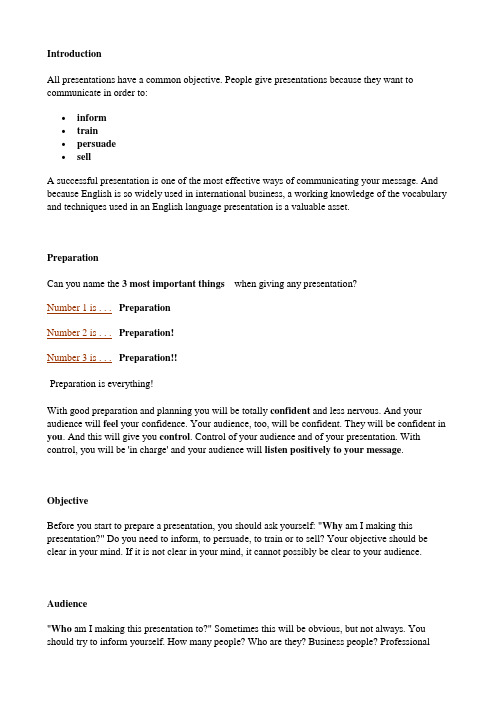
IntroductionAll presentations have a common objective. People give presentations because they want to communicate in order to:∙inform∙train∙persuade∙sellA successful presentation is one of the most effective ways of communicating your message. And because English is so widely used in international business, a working knowledge of the vocabulary and techniques used in an English language presentation is a valuable asset.PreparationCan you name the 3 most important things when giving any presentation?Number 1 is . . .PreparationNumber 2 is . . .Preparation!Number 3 is . . .Preparation!!Preparation is everything!With good preparation and planning you will be totally confident and less nervous. And your audience will feel your confidence. Your audience, too, will be confident. They will be confident in you. And this will give you control. Control of your audience and of your presentation. With control, you will be 'in charge' and your audience will listen positively to your message. ObjectiveBefore you start to prepare a presentation, you should ask yourself: "Why am I making this presentation?" Do you need to inform, to persuade, to train or to sell? Your objective should be clear in your mind. If it is not clear in your mind, it cannot possibly be clear to your audience. Audience"Who am I making this presentation to?" Sometimes this will be obvious, but not always. You should try to inform yourself. How many people? Who are they? Business people? Professionalpeople? Political people? Experts or non-experts? Will it be a small, intimate group of 4 colleagues or a large gathering of 400 competitors? How much do they know already and what will they expect from you?Venue"Where am I making this presentation?" In a small hotel meeting-room or a large conference hall? What facilities and equipment are available? What are the seating arrangements?Time and length"When am I making this presentation and how long will it be?" Will it be 5 minutes or 1 hour? Just before lunch, when your audience will be hungry, or just after lunch, when your audience will be sleepy?MethodHow should I make this presentation?" What approach should you use? Formal or informal? Lots of visual aids or only a few? Will you include some anecdotes and humour for variety?Content"What should I say?" Now you must decide exactly what you want to say. First, you should brainstorm your ideas. You will no doubt discover many ideas that you want to include in your presentation. But you must be selective. You should include only information that is relevant to your audience and your objective. You should exclude all other ideas. You also need to create a title for your presentation (if you have not already been given a title). The title will help you to focus on the subject. And you will prepare your visual aids, if you have decided to use them. But remember, in general, less is better than more (a little is better than a lot). You can always give additional information during the questions after the presentation.StructureA well organised presentation with a clear structure is easier for the audience to follow. It is therefore more effective. You should organise the points you wish to make in a logical order. Most presentations are organised in three parts, followed by questions:NotesWhen you give your presentation, you should be - or appear to be - as spontaneous as possible. You should not read your presentation! You should be so familiar with your subject and with the information that you want to deliver that you do not need to read a text. Reading a text is boring! Reading a text will make your audience go to sleep! So if you don't have a text to read, how can you remember to say everything you need to say? With notes. You can create your own system of notes. Some people make notes on small, A6 cards. Some people write down just the title of each section of their talk. Some people write down keywords to remind them. The notes will give you confidence, but because you will have prepared your presentation fully, you may not even need them!RehearsalRehearsal is a vital part of preparation. You should leave time to practise your presentation two or three times. This will have the following benefits:∙you will become more familiar with what you want to say∙you will identify weaknesses in your presentation∙you will be able to practise difficult pronunciations∙you will be able to check the time that your presentation takes and make any necessary modificationsSo prepare, prepare, prepare! Prepare everything: words, visual aids, timing, equipment. Rehearse your presentation several times and time it. Is it the right length? Are you completely familiar with all your illustrations? Are they in the right order? Do you know who the audience is? How many people? How will you answer difficult questions? Do you know the room? Are you confident about the equipment? When you have answered all these questions, you will be a confident, enthusiastic presenter ready to communicate the subject of your presentation to an eager audience.EquipmentEasily your most important piece of equipment is...YOU! Make sure you're in full working order, and check your personal presentation carefully - ifyou don't, your audience will!The overhead projector (OHP) displays overheadtransparencies (OHTs or OHPTs). It has several advantages overthe 35mm slide projector:∙it can be used in daylight∙the user can face the audience∙the user can write or draw directly on the transparencywhile in useThe whiteboard (more rarely blackboard or greenboard) is a useful devicefor spontaneous writing - as in brainstorming, for example. For preparedmaterial, the OHP might be more suitable.The duster is used for cleaning the whiteboard. It is essential that the duster beclean to start with. You may consider carrying your own duster just in case.Markers are used for writing on the whiteboard (delible - you can remove theink) or flipchart (indelible - you cannot remove the ink). They are usuallyavailable in blue, red, black and green. Again, it's a good idea to carry a spare set of markers in case you are given some used ones which do not write well."A good workman never blames his tools."The flipchart consists of several leaves of paper that you 'flip' or turn over. Somepeople prefer the flipchart to the whiteboard, but its use is limited to smallerpresentations.The Slide projector - which must be used in a darkenedroom - adds a certain drama. Some slide projectors can besynchronised with audio for audio-visual (AV)presentations. These projectors are typically used forlarger presentations. The majority take 35mm slides ortransparencies (as seen here), but projectors for 6x6cm slides are also available.Transparencies are projected by an overhead projector or a slide projector onto ascreen - in this case a folding screen which can be packed up and transported.The notebook computer is increasingly being used to display graphics duringpresentations. It is often used in conjunction with an overhead projector, whichactually projects the image from the computer screen onto the wall screen.Handouts are any documents or samples that you 'hand out' or distribute to youraudience. Note that it is not usually a good idea to distribute handouts before yourpresentation. The audience will read the handouts instead of listening to you.Delivery'Delivery' refers to the way in which you actually deliver or perform or give your presentation. Delivery is a vital aspect of all presentations. Delivery is at least as important as content, especially in a multi-cultural context.NervesMost speakers are a little nervous at the beginning of a presentation. So it is normal if you are nervous. The answer is to pay special attention to the beginning of your presentation. First impressions count. This is the time when you establish a rapport with your audience. During this time, try to speak slowly and calmly. You should perhaps learn your introduction by heart. After a few moments, you will relax and gain confidence.Audience RapportYou need to build a warm and friendly relationship with your audience. Enthusiasm is contagious.If you are enthusiastic your audience will be enthusiastic too. And be careful to establish eye contact with each member of your audience. Each person should feel that you are speaking directly to him or her. This means that you must look at each person in turn - in as natural a way as possible. This will also give you the opportunity to detect signs of boredom, disinterest or even disagreement, allowing you to modify your presentation as appropriate.Your objective is to communicate!Body LanguageWhat you do not say is at least as important as what you do say. Your body is speaking to your audience even before you open your mouth. Your clothes, your walk, your glasses, your haircut, your expression - it is from these that your audience forms its first impression as you enter the room. Generally speaking, it is better to stand rather than sit when making a presentation. Be aware of and avoid any repetitive and irritating gestures. Be aware, too, that the movement of your body is one of your methods of control. When you move to or from the whiteboard, for example, you can move fast or slowly, raising or reducing the dynamism within the audience. You can stand very still while talking or you can stroll from side to side. What effect do you think these two different approaches would have on an audience?Cultural ConsiderationsBecause English is so widely used around the world, it is quite possible that many members of your audience will not be native English-speakers. In other words, they will not have an Anglo-Saxon culture. Even within the Anglo-Saxon world, there are many differences in culture. If we hypothetically imagine a German working for an Israeli company making a presentation in English to a Japanese audience in Korea, we can see that there are even more possibilities for cultural misunderstanding. You should try to learn about any particular cultural matters that may affect youraudience. This is one reason why preparation for your presentation is so important. Cultural differences can also be seen in body language, which we have just discussed. To a Latin from Southern France or Italy, a presenter who uses his hands and arms when speaking may seem dynamic and friendly. To an Englishman, the same presenter may seem unsure of his words and lacking in self-confidence.Voice qualityIt is, of course, important that your audience be able to hear you clearly throughout your presentation. Remember that if you turn away from your audience, for example towards the whiteboard, you need to speak a little more loudly. In general, you should try to vary your voice. Your voice will then be more interesting for your audience. You can vary your voice in at least three ways:∙speed: you can speak at normal speed, you can speak faster, you can speak more slowly - and you can stop completely! You can pause. This is a very good technique for gaining your audience's attention.∙intonation: you can change the pitch of your voice. You can speak in a high tone. You can speak in a low tone.∙volume: you can speak at normal volume, you can speak loudly and you can speak quietly.Lowering your voice and speaking quietly can again attract your audience's interest.The important point is not to speak in the same, flat, monotonous voice throughout your presentation - this is the voice that hypnotists use to put their patients' into trance!Visual aidsOf all the information that enters our brains, the vast majority of it enters through the eyes. 80% of what your audience learn during your presentation is learned visually (what they see) and only 20% is learned aurally (what they hear). The significance of this is obvious:∙visual aids are an extremely effective means of communication∙non-native English speakers need not worry so much about spoken English - they can rely more heavily on visual aidsIt is well worth spending time in the creation of good visual aids. But it is equally important not to overload your audience's brains. Keep the information on each visual aid to a minimum - and give your audience time to look at and absorb this information. Remember, your audience have never seen these visual aids before. They need time to study and to understand them. Without understanding there is no communication.Apart from photographs and drawings, some of the most useful visual aids are charts and graphs, like the 3-dimensional ones shown here:Piecharts are circular in shape (like a pie).Barcharts can be vertical (as here) or horizontal.Graphs can rise and fall.Audience ReactionRemain calm and polite if you receive difficult or even hostile questions during your presentation. If you receive particularly awkward questions, you might suggest that the questioners ask their questions after your presentation.LanguageSay what you are going to say,Simplicity and ClarityIf you want your audience to understand your message, your language must be simple and clear. Use short words and short sentences.Do not use jargon, unless you are certain that your audience understands it.In general, talk about concrete facts rather than abstract ideas.Use active verbs instead of passive verbs. Active verbs are much easier to understand. They are much more powerful. Consider these two sentences, which say the same thing:1.Toyota sold two million cars last year.2.Two million cars were sold by Toyota last year.Which is easier to understand? Which is more immediate? Which is more powerful? N°1 is active and N°2 is passive.SignpostingWhen you drive on the roads, you know where you are on those roads. Each road has a name or number. Each town has a name. And each house has a number. If you are at house N° 100, you can go back to N° 50 or forward to N° 150. You can look at the signposts for directions. And you can look at your atlas for the structure of the roads in detail. In other words, it is easy to navigate the roads. You cannot get lost. But when you give a presentation, how can your audience know where they are? How can they know the structure of your presentation? How can they know what is coming next? They know because you tell them. Because you put up signposts for them, at the beginning and all along the route. This technique is called 'signposting' (or 'signalling').During your introduction, you should tell your audience what the structure of your presentation will be. You might say something like this:"I'll start by describing the current position in Europe. Then I'll move on to some of the achievements we've made in Asia. After that I'll consider the opportunities we see for further expansion in Africa. Lastly, I'll quickly recap before concluding with some recommendations."A member of the audience can now visualize your presentation like this:He will keep this image in his head during the presentation. He may even write it down. And throughout your presentation, you will put up signposts telling him which point you have reached and where you are going now. When you finish Europe and want to start Asia, you might say:"That's all I have to say about Europe. Let's turn now to Asia."When you have finished Africa and want to sum up, you might say:"Well, we've looked at the three continents Europe, Asia and Africa. I'd like to sum up now."And when you finish summing up and want to give your recommendations, you might say: "What does all this mean for us? Well, firstly I recommend..."The table below lists useful expressions that you can use to signpost the various parts of your presentation.。
Presentation在大学英语词汇教学中的应用

Presentation在大学英语词汇教学中的应用论文导读::演示。
大学英语词汇教学一直是大学英语教学中必不可少的一个环节。
传统的词汇教学无非是教师在课堂中给出学生搭配和例句。
论文关键词:presentation,大学英语,词汇教学大学英语词汇教学一直是大学英语教学中必不可少的一个环节。
词汇是英语学习的基础,如果词汇量太少或者词汇掌握不牢,会严重影响学生对英语的理解。
传统的词汇教学无非是教师在课堂中给出学生搭配和例句,学生自己在课下去记忆。
其实,学生拿着词汇书同样可以在课下自行学习单词。
那么,怎样在大学英语课堂有效的时间内去充分调动学生的积极性去有效的学习英语词汇,是众多大学英语教师所关注的问题。
1. 大学英语词汇教学中存在的问题大学英语教材中每个单元所选课文后面都会有几十个单词的词汇表。
由于大学英语的课堂一般人数较多,学生英语水平千差万别,所以教师一般都采取传统的教授法,即教师负责挑选词汇,给出短语和例句,学生上课主要的工作就是记笔记。
这种传统的方式存在以下问题:(1)从学生来看学生们都深知词汇对于学好英语的重要性,也有想把词汇掌握好的愿望。
由于大学英语词汇教学经常采取满堂灌的形式,所以学生常常会感觉疲劳。
有些老师可以用一整节课来讲某一篇课文后面的单词,所以学生往往疲于奔命的记笔记,根本没有时间来考虑老师讲的内容。
久而久之,学生的疲劳感会变成一种厌倦。
而教师往往又会通过听写,背诵和默写这些方式来考察学生对单词的掌握英语论文范文,学生只有无奈的去背诵,有些学生甚至会放弃去记忆词汇。
(2)从教师来看采取满堂灌的传统教学方法的教师,首先自己在备课上会觉得特别辛苦。
由于课堂信息量大,所以教师在课下要收集很多的搭配和例句。
如果要做成课件,就要付出更多的时间和精力。
而在教师付出了巨大的劳动的同时,又会发现课堂效果并不如人意。
学生上课时会疲于记笔记,师生互动少,课堂气氛沉闷,这样也会严重影响到老师的教学情绪论文提纲怎么写。
presentation——专业英语课件PPT
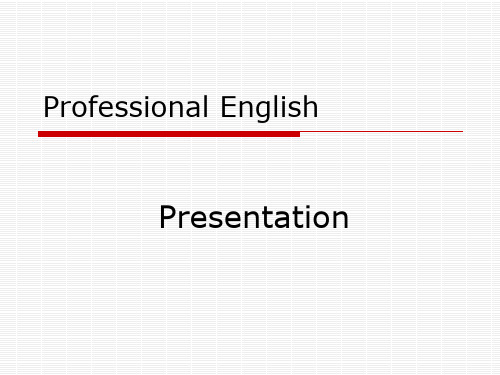
Not to use technical expressions or acronyms unfamiliar to the audience
Employ techniques like: summarization, restatement, enumeration...
Edit for the ear: round off numbers and statistics, avoid
Extemporaneous: prepared and delivered from an outline
3. Presentations usually complement some type of written communication.
4. Presentations usually employ some type of visual aid.
Occasions for selling
5
Typical presentations in the org.
Results of engineering evaluations Status report on affirmative action progron Systems demonstration for upper
Skilled and experienced speaker
Outline
Inexperienced and nervous speakers
Word for word
Suggestions
Use short sentences and avoid complex sentence construction
management Briefings for vendors Briefings for senior executives on community
Presentations演讲技巧
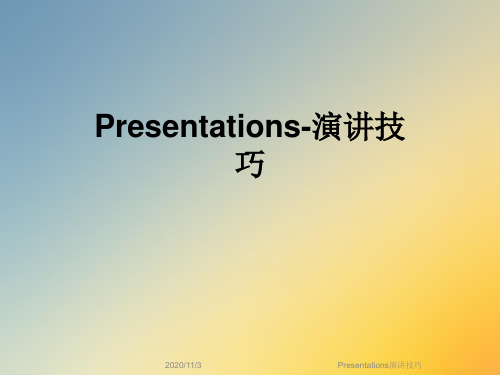
2020/11/3
Presentations演讲技巧
主要内容
引言 准备演讲 开始演讲 即兴演讲
21种演讲技巧 报告技巧
2020/11/3
Presentations演讲技巧
组织你的演讲
❖把你自己看作一个销售人员(推销你的思想). ❖销售人员的第一课
❖告诉人们你想表达的内容. ❖ 开始演讲. ❖ 总结你演讲过的内容
2020/11/3
Presentations演讲技巧
大纲和手稿
大纲.
PowerPoint. 大纲以备必要的时候用.
关于稿件.
不要一直盯住稿件. 提醒的作用
2020/11/3
Presentations演讲技巧
克服紧张
紧张有时候也可以使人兴奋 不要让抖动露出来! 友好的看着大家. 看着听众的上方.
20演讲技巧
结尾
有一定的份量 重复主题 简要回顾要点 感谢听众
2020/11/3
Presentations演讲技巧
布置讲台
房间的合理选择 -大小 -形势 -音响效果 设备到位 -屏幕 -投影仪 -黑板 -笔、教鞭、粉笔等 安排足够的座位
2020/11/3
Presentations演讲技巧
2020/11/3
Presentations演讲技巧
视觉技巧 – 表情
表达感情! 大多数时候:
in public ) 关键词: 听众 自己的见解 美国:面对两个人以上讲话就是演讲
2020/11/3
Presentations演讲技巧
演讲是我们生活学习工作的一部分
调查研究要讲话
动员部署要讲话
总结汇报要讲话
述职竞岗要讲话
交流合作要讲话
presentation讲稿
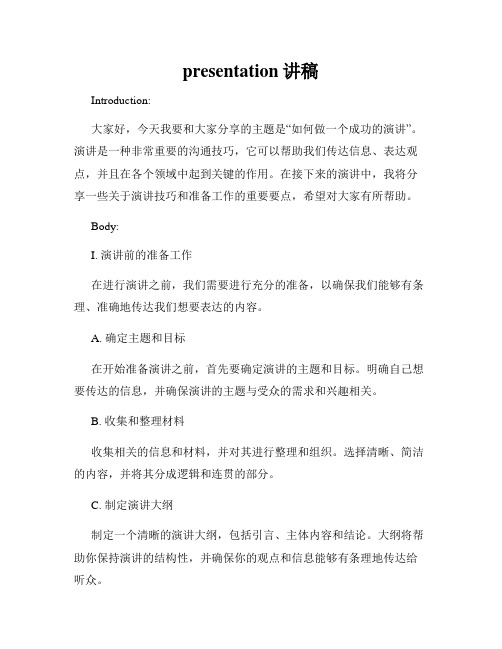
presentation讲稿Introduction:大家好,今天我要和大家分享的主题是“如何做一个成功的演讲”。
演讲是一种非常重要的沟通技巧,它可以帮助我们传达信息、表达观点,并且在各个领域中起到关键的作用。
在接下来的演讲中,我将分享一些关于演讲技巧和准备工作的重要要点,希望对大家有所帮助。
Body:I. 演讲前的准备工作在进行演讲之前,我们需要进行充分的准备,以确保我们能够有条理、准确地传达我们想要表达的内容。
A. 确定主题和目标在开始准备演讲之前,首先要确定演讲的主题和目标。
明确自己想要传达的信息,并确保演讲的主题与受众的需求和兴趣相关。
B. 收集和整理材料收集相关的信息和材料,并对其进行整理和组织。
选择清晰、简洁的内容,并将其分成逻辑和连贯的部分。
C. 制定演讲大纲制定一个清晰的演讲大纲,包括引言、主体内容和结论。
大纲将帮助你保持演讲的结构性,并确保你的观点和信息能够有条理地传达给听众。
II. 演讲技巧一个成功的演讲不仅需要充分的准备,还需要一些技巧和方法来吸引听众的注意力和保持他们的兴趣。
A. 使用肢体语言和面部表情肢体语言和面部表情是演讲时非常重要的元素。
通过适当的姿势、手势和面部表情,可以增强你的演讲效果,并帮助你更好地传达你的思想和情感。
B. 练习演讲技巧练习演讲技巧是提高演讲水平的关键。
通过反复练习,可以提高自己的表达能力和语言流畅度。
可以录制自己的演讲,并进行反思和改善。
C. 使用具体的例子和故事使用具体的例子和故事可以使你的演讲更易于理解和记忆,并吸引听众的兴趣。
通过讲述真实的故事和经历,可以让听众与你建立情感上的联系。
III. 演讲过程中的注意事项在进行演讲时,还需要注意一些细节,以确保演讲的顺利进行并给听众留下良好的印象。
A. 注意语速和声音适当的语速和声音可以帮助你更好地传达信息。
要保持清晰、流畅的语速,并使用适当的音量和语调,以增强演讲的效果。
B. 与听众建立联系与听众建立联系是一种良好的演讲技巧。
presentation讲稿
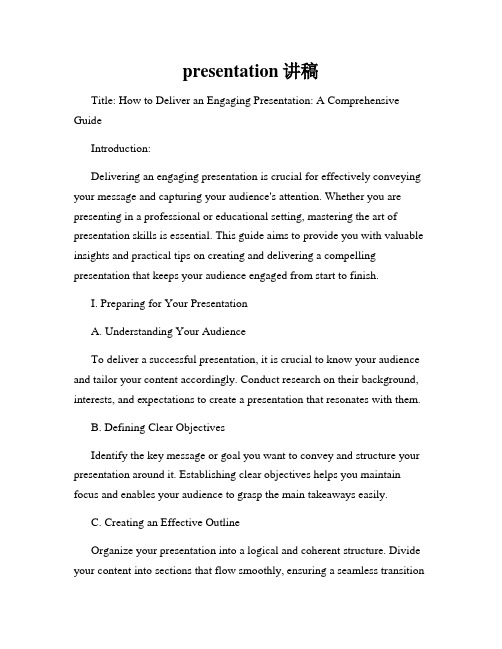
presentation讲稿Title: How to Deliver an Engaging Presentation: A Comprehensive GuideIntroduction:Delivering an engaging presentation is crucial for effectively conveying your message and capturing your audience's attention. Whether you are presenting in a professional or educational setting, mastering the art of presentation skills is essential. This guide aims to provide you with valuable insights and practical tips on creating and delivering a compelling presentation that keeps your audience engaged from start to finish.I. Preparing for Your PresentationA. Understanding Your AudienceTo deliver a successful presentation, it is crucial to know your audience and tailor your content accordingly. Conduct research on their background, interests, and expectations to create a presentation that resonates with them.B. Defining Clear ObjectivesIdentify the key message or goal you want to convey and structure your presentation around it. Establishing clear objectives helps you maintain focus and enables your audience to grasp the main takeaways easily.C. Creating an Effective OutlineOrganize your presentation into a logical and coherent structure. Divide your content into sections that flow smoothly, ensuring a seamless transitionbetween ideas. This will help your audience follow your presentation effortlessly.II. Developing Engaging VisualsA. Choosing the Right Visual ToolsUtilize visual aids such as charts, graphs, images, or videos to enhance your message and engage your audience visually. Use professional presentation software that offers a variety of design options to create visually appealing slides.B. Keeping Visuals Simple and ConsistentAvoid cluttered slides by using minimal text and focusing on key points. Select a consistent color scheme and font style throughout your presentation to maintain visual coherence and professionalism.C. Incorporating Engaging MultimediaIntegrate multimedia elements strategically to complement your content. Embed relevant videos or audio clips that reinforce your message and capture your audience's attention. However, ensure they add value without overshadowing your spoken words.III. Delivering an Engaging PresentationA. Engage Your Audience from the StartBegin your presentation with a captivating opening that grabs your audience's attention immediately. Consider using anecdotes, thought-provoking questions, or compelling visuals to pique their interest.B. Utilizing Body Language and Vocal VarietyMake use of non-verbal communication to enhance your presentation. Maintain good posture, make eye contact, and use gestures to emphasize key points. Vary your tone, pace, and volume to keep your audience engaged throughout.C. Encouraging Audience InteractionIncorporate interactive elements such as Q&A sessions, polls, or group activities to involve your audience actively. Encouraging participation creates a dynamic environment and fosters a sense of connection between you and your listeners.IV. Concluding Your PresentationA. Summarizing Key PointsRecap the main ideas discussed throughout your presentation to reinforce your message in a concise manner. This will help your audience retain crucial information and leave a lasting impression.B. Offering a Call to ActionConclude your presentation with a clear call to action, encouraging your audience to apply the knowledge they have gained. Whether it is taking specific steps, further research, or adopting a new approach, motivate them to act upon the information presented.Conclusion:Mastering the art of delivering an engaging presentation requires careful preparation, captivating visuals, confident delivery, and meaningfulinteraction with your audience. By following the guidelines outlined in this comprehensive guide, you will be well-equipped to create and deliver presentations that leave a lasting impact and effectively share your message with the world.。
制作和讲解Presentation的培训

在表演中,站位是很重要的,表演的时候,演员要注意一上舞台,就要寻找并把自己定位在显眼的位置上。
01
要让所有人都可以看到。
02
这一刻万众瞩目
03
演讲的位置
“表现于人的声调、眼睛和神态中的雄辩决不亚于表现于语言修辞方面的雄辩”————(法国格言)
自信,稳定 应该与听众保持眼睛的接触。 不要总盯住一个人,那是会造成误解。 2个人互相盯着看30秒种,你们可以试试看,一定会出问题,还可能会打断自己的思路。 演讲者对听众眼睛的接触应该是成片成片的接触,当然还要在片之间流动,并在话题之间进行转移,这样也不会给自己以压力。
请使用标题
有效地快速定位你的文档
2
统一
3
当使用“普通”浏览方式时,在内容部分使用“最佳显示”的显示比例;
能够使你在调整页面时总是获得整页的概览
在左边的窗口中全选折叠
能够使你容易获得对整体的概览
一些推荐的写作习惯
讲解的位置
22%
讲解的节奏
40%
讲解的目光
38%
演讲方法改善篇
开头和结尾的处理
68%
过多的目的容易顾此失彼
造成思路凌乱,难以清晰
8
给否定者以机会,利用对一部分论点的否定,来否定整体论点
9
你的思路是什么?
一个成功的演讲,一定是成功地演绎了一个完整的思路,引导听众得出了一个结论 推理的过程力求严密 推理的过程应该逻辑清晰,缜密,“概念偷换”的使用应视乎场合,不可滥用; 推理的思路应该连贯,不可凌乱; 听众对结论的接受其实就是对论证过程的接受; 无关的论点或论据应该删去;
时间的长短取决于多种因素,但衡量时间长短的最终标准是:它是否最有利于达到演讲的目的?
Presentation开场白及结束语
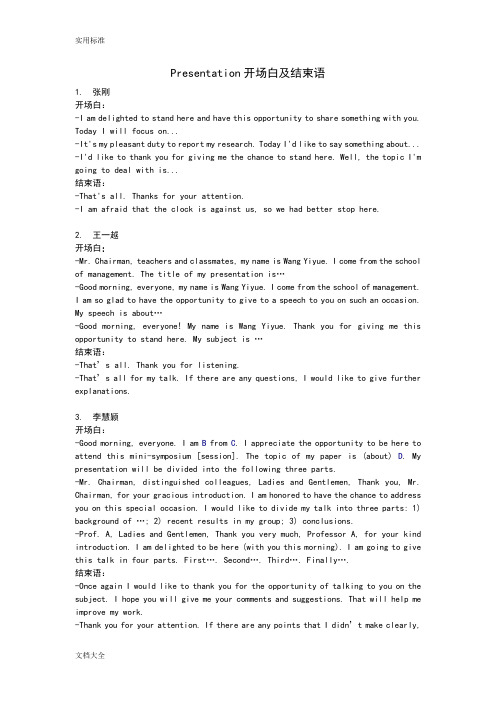
Presentation开场白及结束语1. 张刚开场白:-I am delighted to stand here and have this opportunity to share something with you. Today I will focus on...-It's my pleasant duty to report my research. Today I'd like to say something about... -I'd like to thank you for giving me the chance to stand here. Well, the topic I'm going to deal with is...结束语:-That's all. Thanks for your attention.-I am afraid that the clock is against us, so we had better stop here.2. 王一越开场白:-Mr. Chairman, teachers and classmates, my name is Wang Yiyue. I come from the school of management. The title of my presentation is…-Good morning, everyone, my name is Wang Yiyue. I come from the school of management.I am so glad to have the opportunity to give to a speech to you on such an occasion. My speech is about…-Good morning, everyone! My name is Wang Yiyue. Thank you for giving me this opportunity to stand here. My subject is …结束语:-That’s all. Thank you for listening.-That’s all for my talk. If there are any questions, I would like to give further explanations.3. 李慧颖开场白:-Good morning, everyone. I am B from C. I appreciate the opportunity to be here to attend this mini-symposium [session]. The topic of my paper is (about) D. My presentation will be divided into the following three parts.-Mr. Chairman, distinguished colleagues, Ladies and Gentlemen, Thank you, Mr. Chairman, for your gracious introduction. I am honored to have the chance to address you on this special occasion. I would like to divide my talk into three parts: 1) background of …; 2) recent results in my group; 3) conclusions.-Prof. A, Ladies and Gentlemen, Thank you very much, Professor A, for your kind introduction. I am delighted to be here (with you this morning). I am going to give this talk in four parts. First…. Second…. Third…. Finally….结束语:-Once again I would like to thank you for the opportunity of talking to you on the subject. I hope you will give me your comments and suggestions. That will help me improve my work.-Thank you for your attention. If there are any points that I didn’t make clearly,please point them out and I would like to give further explanations.4. 佟诚德开场白:-Good morning everybody. It is really an honor for me to give a report here. In the next ten minutes, I will focus on the following three aspects. First, … . Then, … . At last, … .-I’m very pleased to be here to share my ideas with all of you. It is a great opportunity and challenge as I have only 5 minutes for presentation. So I can only give a brief introduction to my work and questions at the end are welcomed…-Hello, everyone. My topic today is … and I shall address myself to the following contents…结束语:-That’s all for my presentation. Thanks for listening. Thank you all.-Well, I think we are running short of time and my presentation should be over. Thank you for your attention.5. 焦炎开场白:- Mr. President, ladies, and gentlemen:I never suspected that I was to have so great an honor, so carefully given, as to become a follower of the distinguished speaker who has just taken his seat.- Mr. President and gentlemen:I am obliged to my friend Dr. Clarke for the complimentary terms in which he has presented me to you. But I must appeal to your commiseration. Harvard and Yale! Can any undergraduate of either institution, can any recent graduate of either institution, imagine a man responding to that toast? However, I must make the best of the position, and speak of some points upon which the two institutions are clearly agreed. And here I am reminded of a story of a certain New England farmer, who said that he and ‘Squire Jones had more cows between them than all the rest of the village; and his brag being disputed, he said he could prove it, for the ‘Squire had forty-five cows and he had one, and the village altogether had not forty-six.-Honorable Vice Premier Madame Wu Yi, Distinguished guests, Ladies and gentlemen: On behalf of Emerson, I would like to thank you for this great honor to share our thoughts with you regarding economic development and investment inside China. For many years, Emerson has participated in this important conference and I am delighted to be here addressing this gathering today--- a tremendous honor.结束语:-Once again, I would like to thank the Ministry of Commerce and the CIFIT conference for giving me the opportunity to talk to you today. Have a good day and thanks for listening.-So, I close in saying that I might have been given a bad break, but I've got an awful lot to live for.6. 祝元坤开场白:--Good morning everybody! It's my honor to speak here, and I am very glad to share my topic with you. Then today I'd like to talk something about...-Good morning! I feel really honored to stand here and make a presentation. Today I'm going to look together with you into this topic:-Good afternoon everyone! First, I am so pleased to have a presentation here. Today, I am going to talk about...结束语:-That's all. Thank you for you attention!-Thank you for listening, if you have any question please be free to ask.7. 王冠石开场白:-I may be permitted at the outset, to speak a little about the share that we have taken on this side of water in this great achievement which in its glorious consummation, now receives the applause of the world.-In this symposium my part is only to sit in silence. to express one's feeling as the end draws near to intimate a task.-I want to talk to you tonight from my heart on a subject of deep concern to everyone. 结束语:-and so I end with a line from a Latin poet who uttered the message more than fifteen hundred years ago, "death plucks my ear and says: live-I am coming."-And finally we have that gentler phrase, that one which shows you another true side of the man, shows you that in his soldier heart there was room for other than glory war mottoes and in his tongue the gift to fitly phrase them-"let us have peace."8. 韩修柱开场白:-Good morning,everyone,my honored teacher and my fellow students.I'm very honored to be the host for today's presentation this afternoon .my presentation is about extrusion process under warm temperature. Now let’s warmly welcome Mr./Mrs. ... to give us presentation.-hello everyone, I am glad and proud of myself to be here to introduce our smart and experienced doctor, Mr.… . He will give us his new presentation about… OK, let’s give him our warmly welcome. Thank you.-Ladies and gentlemen, I am honored to be here to introduce Mr.… His presentation is about… as far as we know, …is the hot point in study field, I am sure you are interested in new development in this field, so I think we should listen this presentation carefully. Let’s welcome Mr.…结束语:-That is all, thanks for your attention. Thank you!-Thanks for your attention. Maybe my presentation has some aspects you do not understand fully, you can ask me after the presentation. Maybe my presentation hassomething which is not correct, you can give me your advice and correct them, thanks again.-That is all my presentation, thanks for your coming, if you can have any questions, you can ask me now. OK, thank you !9. 袁鹤然开场白:-Mr. Chairman, ladies and gentleman,I am delighted/pleased/glad to have the opportunity to present/of making this presentation. The title of my presentation is…- Good morning/afternoon/evening ladies and gentleman,I'd like to thank you for inviting/asking me/giving me the chance to report my research on such an occasion. Before we start our presentation, let's take a brief look at the agenda…- Mr. Chairman, representatives,The subject of my presentation/I shall be speaking today about/My presentation concerns/Today's topic is... There are five main aspects to this topic (...the first, ... the second, ...a third, ...another, ... the final)结束语:-I am afraid that the clock is against us, so we had better stop here. Thank you, Mr. Chairman, Thank you all.-I hope this has given you some idea/clear idea/an outline of... If there are any questions, please point them out and I would like to give further explanations.10. 苏文涛开场白:-Good afternoon and thank you for coming today. My name is…, and I'm the Project Manager in Taipei for …-I am glad that I can stand here and give all of you my speech about…-Ladies and Gentlemen, you must have heard that….and today my topic is…结束语:-That is all. Thanks for your attention.-That is what I want to say, if you have any question, you can ask now.11. 张可心开场白:-Good morning everyone! I am honored to be with you today to...-I'm very happy to have this opportunity to...结束语:-That's all, thank you.-Any other question please send email to... Thank you for your attention.12. 侯赵平开场白:-I am delighted/pleased/glad to have the opportunity to present/of making this presentation...-I am grateful for the opportunity to present...-I'd like to thank you for inviting/asking me/giving me the chance to...结束语:-Stay hungry. Stay foolish. Thank you all very much.-OK, thank you for listening, that's all.-That's it. We have known several habits which could be really amazing if you do them from now on. And... believe me...I am not fooling you, never! All right, now it's (下一个同学的名字或老师) time. Thank you everyone!13. 何鹏开场白:-Good morning,ladies and gentlemen. The main ideas of my presentation are as follow:...-Mr. Chairman, thank you for introducing me to everyone here. It’s my honor to show my research results...-Thank you, Mr. Chairman. The meeting is excellent, and I am very glad here. My presentation include the following结束语:-That’s all! Thank you for your attention.-As an end, my presentation is over. Thank you!-That’s all! Thank you all!14. 严柏平开场白:-Good morning/afternoon/evening ladies and gentleman-The purpose of this plenary session is to...-I am delighted/pleased/glad to have the opportunity to present/of making this presentation…结束语:-I hope I've managed to give you a clearer picture of...-If there are any questions, I'd be delighted to...15. 张伟开场白:-Ladies and Gentlemen, today I will talk about....-Hello everybody, my name is zhangwei, now we will discuss...结束语:-Thank you all for listening.-Thanks.16. 聂凯波开场白:-Mr. chairman, ladies and gentlemen,The title of my presentation is ×××. I am very glad to have the opportunity to report my research on such an occasion. I will lay my stress on the following three aspects.-Mr. chairman,Thank you for your warm introduction and also for your efforts in making the opening of the conference so successful. Just now the over-praised introduction you gave me, I think, is meant for the study on ××× that I have been carrying on in recent years. Now I would like to say something about the study, and I will welcome your comments at the end.-Mr. chairman,It is a great honor to have the chance to report my research. The title of my presentation is ×××.结束语:-Now that I have finished my speech, I hope you will give me your comments and suggestions. That will help me improve my work.-That’ all for my talk. If there are any points that I didn’t make clearly, please point them out and I would like to give further explanations.17. 杨晓光开场白:-Good morning, ladies and gentlemen, today my topic is…-Mr. Chairman, ladies and gentlemen, I am very glad to give my presentation here today, my topic contains three points as follows…-Mr. chairman, Thank you for your warm introduction and also for your efforts in making the opening of the conference so successful. Just now the over-praised introduction you gave me, I think, is meant for the study on”…”, now I would like to say something about the study, and I will welcome your comments at the end…结束语:-That’s all, thank you everyone, thank you for your attention.-Now that I have finished my speech, I hope you’ll give me your comments and suggestions. That’ll help me improve my work.18. 刘昕应对问题:-I will be pleased to answer any questions you may have at the end of the presentation. -Please can you save your questions till the end.-If you have any questions, I will be pleased to answer them at the end of the presentation.-there will be time at the end of the presentation to answer your questions-so please feel free to ask me anything then.-Don't hesitate to interrupt if you have a question.-Please feel free to interrupt me at any time.-Please stop me if you have any questions.-If you need clarification on any point, you're welcome to ask questions at any time.-Can I come back to that point later?-I will be coming to that point in a minute.-That's a tricky question.-We will go into details later. But just to give you an idea of...-I am afraid there's no easy answer to that one...-Yes, that's a very good point.-Perhaps we could leave that point until the questions at the end of the presentation -I think I said that I would answer questions at the end of the presentation---perhaps you wouldn't mind waiting until then.-I think we have time for just one more question欢迎听众(正式):-Welcome to our company-I am pleased to be able to welcome you to our company...-I'd like to thank you for coming.-May I take this opportunity of thanking you for coming欢迎听众(非正式):-I'm glad you could all get here...-I'm glad to see so many people here.-It's great to be back here.-Hello again everybody. Thank you for being on time/making the effort to come today. -Welcome to X Part II.受邀请在会议上致词:-I am delighted/pleased/glad to have the opportunity to present/of making this presentation...-I am grateful for the opportunity to present...-I'd like to thank you for inviting/asking me/giving me the chance to...-Good morning/afternoon/evening ladies and gentleman-It's my pleasant duty today to...-I've been asked to...告知演讲的话题:-the subject of my presentation is...-I shall be speaking today about...-My presentation concerns...-Today's topic is...-Today we are here to give a presentation on...-Today we are here to talk about...Before we start, I'd like you meet my team members...-A brief look at today's agenda...(告诉听众所讲内容的先后顺序)-Before we start our presentation, let's take a brief look at the agenda...-I shall be offering a brief analysis of...-the main area that I intend to cover in this presentation is...-Take a moment and think of...-Thank you for giving me the opportunity to tell you about...告诉听众发言的长度:-During the next ten minutes, I shall...-I shall be speaking for about ten minutes...-My presentation will last for about ten minutes...-I won't take up more than ten minutes of your time...-I don't intend to speak for longer than ten minutes...-I know that time is short, so I intend to keep this brief-I have a lot to cram in to the next ten minutes, so I'd better make a start... 引起听众的兴趣:-I'm going to be speaking about something that is vitally important to all of us. -My presentation will help solve a problem that has puzzled people for years... -At the end of this presentation you will understand why this company has been so successful for so long...-I am going to be talking about a product that could double your profit margins... -the next ten minutes will change your attitude to sales and marketing...-Over the next ten minutes you are going to hear about something that will change the way your companies operate...-By the end of this presentation you will know all there is to know about...告诉听众内容要点:-there are five main aspects to this topic (...the first, ... the second, ...a third, ...another, ... the final)-I am going to examine these topics in the following order (...first, ...next, ...after that, ...finally)-I've divided my talk into five parts...-I will deal with these topics in chronological order...-I'm going to start with a general overview and then focus on this particular problem (...in general, ...more particularly).-I want to start with this particular topic, and then draw some more general conclusions from it (...specifically, ... in a wider context).-there are (a number of) factors that may affect...-We have to take into account in any discussion of this subject, the following considerations.-We all ought to be aware of the following points.结束语:-In conclusion, I'd like to...-I'd like to finish by...-Finally...-By way of conclusion...- hope I have made myself understood-I hope you have found this useful-I hope this has given you some idea/clear idea/an outline of...-Let me end by saying...-That, then was all I had to say on...-That concludes our presentation...-I hope I've managed to give you a clearer picture of...-If there are any questions, I'd be delighted to...-Thank you for your attention...-Let's break for a coffee at this point-I am afraid that the clock is against us, so we had better stop here -You have been a very attentive audience---thank you。
OralEnglishpresentation讲稿
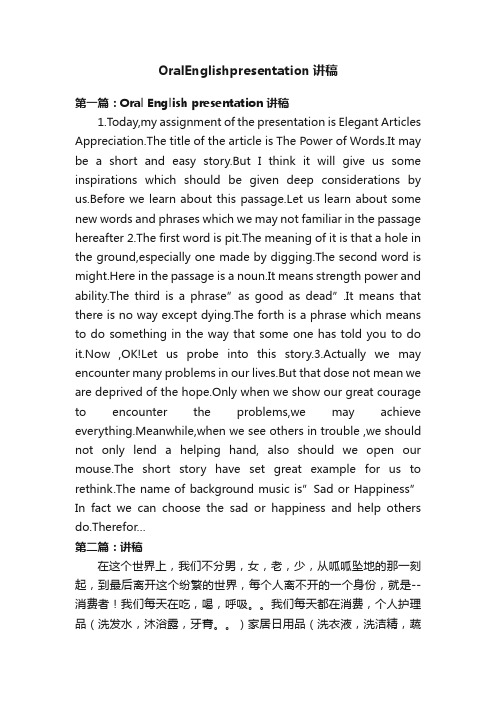
OralEnglishpresentation讲稿第一篇:Oral English presentation 讲稿1.Today,my assignment of the presentation is Elegant Articles Appreciation.The title of the article is The Power of Words.It may be a short and easy story.But I think it will give us some inspirations which should be given deep considerations by us.Before we learn about this passage.Let us learn about some new words and phrases which we may not familiar in the passage hereafter2.The first word is pit.The meaning of it is that a hole in the ground,especially one made by digging.The second word is might.Here in the passage is a noun.It means strength power and ability.The third is a phrase”as good as dead”.It means that there is no way except dying.The forth is a phrase which means to do something in the way that some one has told you to do it.Now ,OK!Let us probe into this story.3.Actually we may encounter many problems in our lives.But that dose not mean we are deprived of the hope.Only when we show our great courage to encounter the problems,we may achieve everything.Meanwhile,when we see others in trouble ,we should not only lend a helping hand, also should we open our mouse.The short story have set great example for us to rethink.The name of background music is”Sad or Happiness” In fact we can choose the sad or happiness and help others do.Therefor…第二篇:讲稿在这个世界上,我们不分男,女,老,少,从呱呱坠地的那一刻起,到最后离开这个纷繁的世界,每个人离不开的一个身份,就是--消费者!我们每天在吃,喝,呼吸。
英语课堂presentation
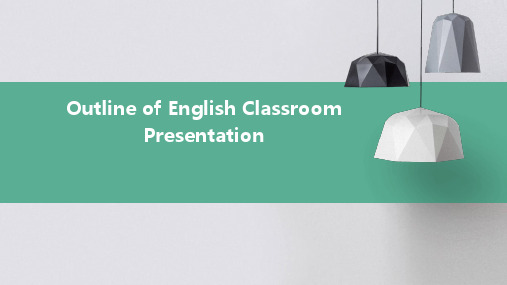
通过模仿和实践,学习正确的英语发音技巧,包括音节、重音、连读、语调和节奏等。
03
English listening and speaking ability
Listening skills
Comprehension of Spoken English
The ability to understand and analyze the content and context of English speech, including the identification of key information, inference of meanings, and understanding of cultural and social references.
Vocabulary and Grammar
A good comprehension of English vocabulary and grammar is essential for
effective reading. The ability to understand complex sentences, decipher unfamiliar words, and identify grammatical structures is crucial.
Vocabulary learning
掌握基础词汇
学习英语的基础词汇,包括常见名词、动词、形容词和副词等,以及它们的用法 和搭配。
Grammar parsing
理解语法结构
学习英语的基本语法结构,如句子成分、时态、语态、语气等,以及各种类型的句子和从句。
Pronunciation training
- 1、下载文档前请自行甄别文档内容的完整性,平台不提供额外的编辑、内容补充、找答案等附加服务。
- 2、"仅部分预览"的文档,不可在线预览部分如存在完整性等问题,可反馈申请退款(可完整预览的文档不适用该条件!)。
- 3、如文档侵犯您的权益,请联系客服反馈,我们会尽快为您处理(人工客服工作时间:9:00-18:30)。
– Habitat isolation
– Behavioral isolation – Mechanical isolation
– Gametic isolation
© 2010 Pearson Education, Inc.
PREZYGOTIC BARRIERS Temporal Isolation Habitat Isolation
Sterile next-generation rice hybrid
Figure 14.5c
Mechanisms of Speciation
• A key event in the potential origin of a species occurs when a population is severed from other populations of the parent species.
• Macroevolution:
– Encompasses the major biological changes evident in the fossil record
– Includes the formation of new species
© 2010 Pearson Education, Inc.
© 2010 Pearson Education, Inc.
Allopatric speciation
Simpatric speciation
Figure 14.6
Allopatric Speciation
• Geologic processes can:
– Fragment a population into two or more isolated populations
Figure 14.1
• In branching evolution, one or more new species branch from a parent species that may:
– Continue to exist in much the same form or – Change considerably
– Pave the way for the evolution of new and diverse forms, but – Take millions of years for Earth to recover
© 2010 Pearson Education, Inc.
MACROEVOLUTION AND THE DIVERSITY OF LIFE
© 2010 Pearson Education, Inc.
• Species can form by:
– Allopatric speciation, due to geographic isolation
– Sympatric speciation, without geographic isolation
Behavioral Isolation
Mechanical Isolation
Gametic Isolation
Figure 14.4
Temporal Isolation
Skunk species that mate at different times
Figure 14.4a
Habitat Isolation
Diversity within one species
Fiபைடு நூலகம்ure 14.2b
• The biological species concept cannot be applied in all situations, including:
– Fossils – Asexual organisms
Garter snake species from different habitats
Figure 14.4b
Behavioral Isolation
Mating ritual of blue-footed boobies
Figure 14.4c
Mechanical Isolation
Snail species whose genital openings cannot align
© 2010 Pearson Education, Inc.
POSTZYGOTIC BARRIERS
Reduced Hybrid Viability Reduced Hybrid Fertility Hybrid Breakdown
Horse
Donkey
Mule
Figure 14.5
Reduced Hybrid Viability
© 2010 Pearson Education, Inc.
Similarity between different species
Diversity within one species
Figure 14.2
Similarity between different species
Figure 14.2a
– A population transforms but
– Does not create a new species
Video: Galápagos Islands Overview
© 2010 Pearson Education, Inc.
PATTERNS OF EVOLUTION Nonbranching Evolution (no new species) Branching Evolution (results in speciation)
Lectures by Chris C. Romero, updated by Edward J. Zalisko
© 2010 Pearson Education, Inc.
Biology and Society: The Sixth Mass Extinction
• Over the past 600 million years the fossil record reveals five periods of extinction when 50–90% of living species suddenly died out.
Temporal isolation Habitat isolation Behavioral isolation MATING ATTEMPT
Mechanical isolation
Gametic isolation
FERTILIZATION (ZYGOTE FORMS) Postzygotic Barriers
Video: Blue-footed Boobies Courtship Ritual
Video: Giraffe Courtship Ritual
© 2010 Pearson Education, Inc.
INDIVIDUALS OF DIFFERENT SPECIES
Prezygotic Barriers
• The biological species concept defines a species as
– “A group of populations whose members have the potential to interbreed and produce fertile offspring”
Temporal isolation
Habitat isolation
Behavioral isolation MATING ATTEMPT Mechanical isolation Gametic isolation
Figure 14.3a
INDIVIDUALS OF DIFFERENT SPECIES
– Hybrid zygotes form
© 2010 Pearson Education, Inc.
• Postzygotic barriers include:
– Reduced hybrid viability
– Reduced hybrid fertility
– Hybrid breakdown
© 2010 Pearson Education, Inc.
THE ORIGIN OF SPECIES
• Species is a Latin word meaning:
– “Kind” or
– “Appearance.”
© 2010 Pearson Education, Inc.
What Is a Species?
• Speciation:
– Is the focal point of macroevolution
– May occur based on two contrasting patterns
© 2010 Pearson Education, Inc.
• In nonbranching evolution:
– Contribute to allopatric speciation
Video: Lava Flow
Video: Volcanic Eruption
© 2010 Pearson Education, Inc.
Figure 14.00
• Our current rate of extinction, over the past 400 years, indicates that we may be living in, and contributing to, the sixth mass extinction period. • Mass extinctions:
